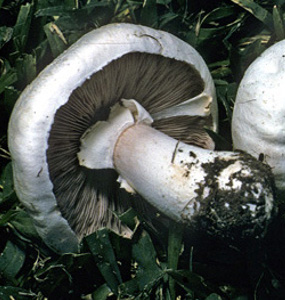
.jpg)
bisporus are predominantly found at the extreme ends of chromosomes ( Foulongne-Oriol et al., 2010 Sonnenberg et al., 2016, 2020). burnettii crossovers (CO) are found more or less evenly spread over chromosomes, CO in var. Next to the difference in sexual reproduction, the main varieties bisporus and burnettii also differ in recombination landscape. bisporus in forming predominantly four-spored basidia resulting in homokaryons after germination of spores and a minority of basidia bear two or three spores ( Callac et al., 1993). On rare four-spored basidia each spore receives one haploid nucleus and germinates into an infertile homokaryon, tri-spored basidia produce likely two homokaryotic and one heterokaryotic spores ( Pelham, 1967 Elliott, 1972). bisporus basidia bear two spores each receiving non-sister nuclei after meiosis ( Kerrigan et al., 1993 Sonnenberg et al., 2016) and these produce fertile heterokaryons after germination. eurotetrasporus true homothallic ( Raper and Raper, 1972 Callac et al., 1993, 2003). burnettii predominantly heterothallic and var. bisporus is predominantly pseudohomothallic, var. To unravel the genetic base of different life cycles in basidiomycetes, the button mushroom, Agaricus bisporus is a useful model species since it represents three interfertile varieties with considerable differences in life cycles. This new approach can be a useful strategy for a more efficient breeding strategy for mushrooms in general. Homokaryotic offspring of these hybrid mushrooms can be genotypes to assess CO positions using next generation sequencing technologies that will solve marker problems encountered, especially for genotyping chromosome ends. Homokaryotic offspring of both populations can be intercrossed without limitation of mating incompatibility and marker homozygosity and the hybrid mushrooms directly used to map BSN. burnettii homokaryon and thus segregating both for CO and BSN. We propose to use two genetically unrelated mapping populations both offspring of a cross between a var. The hurdles encountered are discussed and a new strategy is proposed that can solves these. Nevertheless, this was done, and we were able to map three QTLs for this trait, two on chromosome 1 and one on chromosome 2 not overlapping with the QTL for BSN. This phenotype can only be assessed in the meiotic offspring of an intervarietal hybrid which is a laborious and difficult task. It appeared, however, difficult to map the recombination landscape.

For BSN, in total seven QTL were found with the major QTL on chromosome 1 explaining ca. Knowledge on genes controlling CO positions might facilitate either the conservation of favorable allele combinations or the disruption of unwanted allele combinations to reduce linkage drag. The two varieties are compatible, and this has been used to study segregation of the basidial spore number (BSN) and the genomic positions of recombination, i.e., the CO landscape, in order to find the underlying genetic determinants. Both varieties also differ in their recombination landscape with the former showing crossovers (CO) predominantly at chromosome ends whereas the latter has a more evenly distribution of CO over the chromosomes. The button mushroom Agaricus bisporus is represented mainly by two varieties, a secondarily homothallic variety with predominantly two heterokaryotic spores per basidia and a heterothallic variety with predominantly four homokaryotic spored basidium. Plant Breeding, Wageningen University and Research, Wageningen, Netherlands.

Sonnenberg * †, Narges Sedaghat-Telgerd † ‡, Brian Lavrijssen, Patrick M.


 0 kommentar(er)
0 kommentar(er)
